1993 Hungarian Grand Prix: Son of the father
When it finally came along, Damon Hill’s first F1 victory was much easier than one might have expected.
A little bit of history was made in Hungary and a lot of history added to. At last, after the disappointments of Spain, Silverstone and Germany, the cards finally fell right for Damon Hill as he scored a lights-to-flag victory for Williams-Renault.
In doing so he became the first ever second-generation driver to emulate a successful father’s World Championship Grand Prix victory. Only Alberto Ascari before him could boast that he had repeated father Antonio’s pre-Championship successes of the early ’20s.
For Damon, the first win came after only 13 tries. While that undoubtedly owes a massive amount to the superiority of the Williams, nothing could detract from a fine performance that kicked off his victory score and made him the 14th Briton to achieve Grand Prix success. It was Britain’s 148th GP win, and it increased the Hill name’s tally to 15. “I dedicate this victory to the Hill family, past, present and future,” he said without affectation.
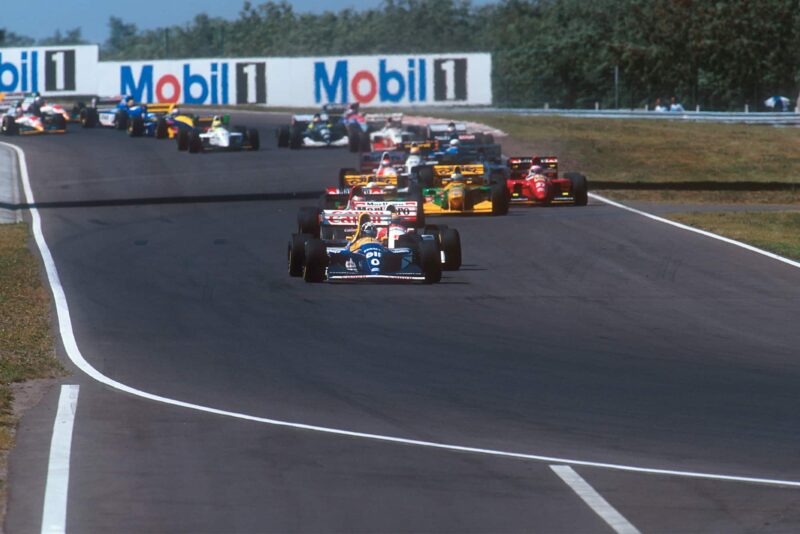
Damon Hill leads the field approaching Turn Two
Motorsport Images
In some ways, his first was similar to his father’s last. When Graham Hill won at Monaco in 1969, principal opponents Jackie Stewart and Chris Amon retired early, leaving him to come through from third and then lead for the majority of the event. In Hungary Hill’s main rivals either made mistakes, fell by the wayside, or both. The difference is that all of them were behind him when they went.
Prost was the first to go, and this was a Prost who had again been fired up for pole position in qualifying despite not one but two uncharacteristic spins. One came in free practice on Saturday morning, the other as he tried to push his pole lap time a fraction lower to protect it in case Hill found the extra two tenths of a second that he needed. Hill, alone of the front runners, did not spin at any stage of his weekend. “When you go round here you are just trying to find a few tenths, and you think that you have to try and tidy up every slide,” he said of the track. “You have to concentrate all the time. It’s very good fun to drive on this circuit. It’s very technical, but it’s a bit like a big kart circuit. There are so many corners and so many different types that it’s almost better to find an average, rather than trying to be overgood on one part and lose out on another. It’s really a matter of being very precise throughout the lap.”
On Friday, he had looked a little at sea to be frank, missing apexes, taking unusual lines. ‘Hah!’ said some. ‘We knew Magny-Cours, Silverstone and Hockenheim were flukes! He isn’t as quick as Prost, is he?’
If he was, it would be stunning for as he has shown in the past, when he cares to be, Mr Prost is as quick as Ayrton Senna. That says it all. Quite possibly, Alain is driving to a standard sufficient just to beat his team-mate this year. Unless he ever gets to run the Williams with established quantities such as Mansell or Senna alongside, we shall never know for sure. But be that as it may, you cannot take anything away from Hill. If he isn’t as fast as Prost, he’s not far off. His confidence enhanced by Saturday, when Friday’s braking problems were a thing of the past, he ran him very close for the premier grid position that, conventional wisdom had it, was so vital on a circuit said to rival Monaco for lack of overtaking opportunities. As Prost would show in the race, however, if you had a Williams you can pass anyone at the Hungaroring.
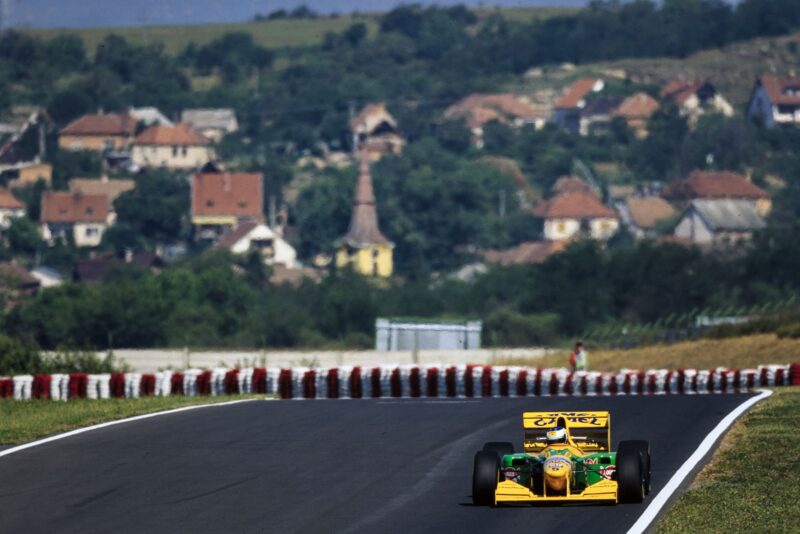
Michael Schumacher’s Benetton
Motorsport Images
What he couldn’t do, however, was get his off the line. As the field went off on the final, green flag lap before the start, Williams number two sat stranded on the grid. Amazingly, after all the problems he’s had starting this season, and all the practice starts he has recently done, Alain had stalled, just as he did in Monaco. The crew eventually got him going again, but by then it was way too late. Under the rules he had no option but to take up position behind even the tardy Lola-Ferraris. Prior to the meeting much had been expected of the combination of Michael Schumacher and the Benetton-Ford. It’s a nimble little car, which has made great technical strides since Monaco. Since the Ford engine requires less fuel than the Renault, it should also have had a subtle weight advantage in the early stages. As qualifying had shown, Schumacher got very close indeed to the Williams (he’d actually split them after the first official session), and with Prost in trouble he had a nice open space ahead of his third slot on the grid . . .
Hill has been a master starter all year, but there was the question in Hungary: Would he get stage fright in the wake of his team-mate’s demise? There was also the matter of his position on the right-hand side of the grid, on the dirtier line. The Williams crew had actually washed that part of the track on Saturday night, and he had cleverly attempted to clean it up further by running tightly into the first corner during the closing stages of the morning warm-up, although he later said his success there had been qualified. When the lights turned green, though, his response to all questions was robust. “I think that was my best of the year!” he smiled afterwards, and the Williams launched itself at the first corner as, further back, Gerhard Berger and Pier-Luigi Martini also got away very well. Instead of Hill, it was Schumacher who fluffed the Big Occasion. As the German opted for the outer line. which can reap benefits with the better line for turn two, he got on to the dust which forever seems to lie off the racing line at the track. At the same time Berger came boiling through between the Benetton and Senna, as the latter tried to slip through on the inside. The Ferrari momentarily grabbed second place before the McLaren deposed it exiting the corner, and as Patrese in the other Benetton got a clean start, Schumacher slithered his way down to fifth. Not impressive.
Senna pushed Hill very hard through the first couple of corners, but by the end of the lap the gap between them was 1.797s and the writing was already on the wall.
What Williams proved in Hungary, to the consternation of its rivals, is that catching it in qualifying is one thing; matching its race pace is something else.
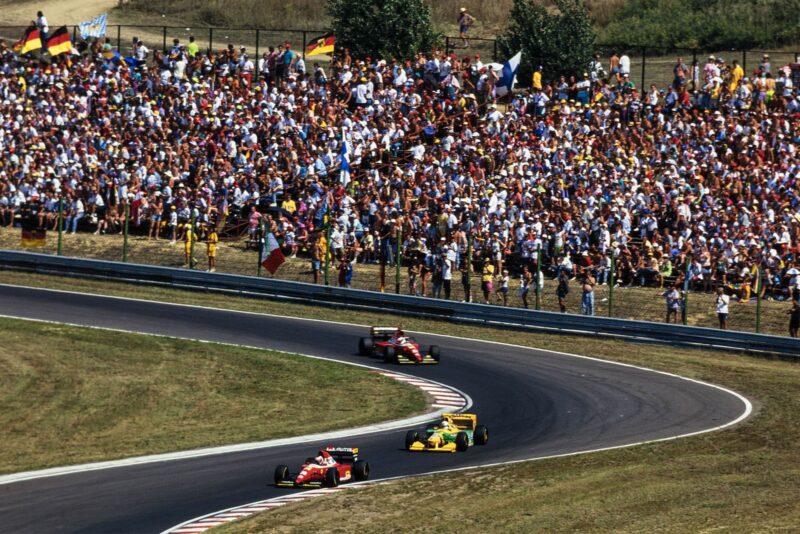
Gerhard Berger leads Riccardo Patrese and Ferrari team-mate Jean Alesi
Motorsport Images
While Hill drew steadily away, Senna kept hold of second as Berger used a Ferrari with improved active suspension software to keep Patrese and Schumacher at bay. By prior arrangement Riccardo, having been told during the weekend that he was a free agent for 1994, had agreed to let Michael by if necessary, but it took the German until lap four before he found a way by Gerhard in a bold move round the outside of the first corner. No sooner had he done that, however, than he spun of his own accord at the top of the hill, dropping back to 10th place behind Hill, Senna, Berger, Patrese, Alesi, Andretti, Warwick, Martini and Brundle. That was mistake number two. Gradually he worked his way through again. Brundle succumbed on lap five, Martini and Warwick on six. Andretti steadfastly rebuffed his advances for the next nine laps, and then Schumacher’s momentum was interrupted further when the American retired on lap 16. As the McLaren slowed ahead of him, the German had to take to the grass to avoid contact, and filled the Benetton with stones and debris. Undaunted, he passed Alesi on lap 17, and moved up another place when Senna’s run ended a lap later.
Both McLarens out within 20 laps? We might have become accustomed to Michael’s early retirements, but Senna usually goes the distance. This time both had suffered throttle problems, albeit of a different nature. The American’s promising run, which might well have reaped him second place by the finish, was damned when the small cable that connects his throttle pedal to the electronic potentiometer snapped. The fly-by-wire system could no longer be operated, and he rolled slowly down to the pits and drove straight into the garage. Senna probably dared not believe his good fortune in those early laps as he ran second, for a dire lack of grip and balance in qualifying had suggested such a high position was beyond even his reach. However, it did not take long for him to detect a problem with his throttle. It was behaving erratically, and as the team tried in vain to spot anything on the telemetry, he was advised to avoid part-throttle applications. Using his renowned technique of throttle blipping through corners, he kept going until the system suddenly cut out altogether at the top of the circuit.
Only Berger now separated Schumacher from Hill, and to be fair Michael gave it everything he had. Everyone expected to stop for fresh Goodyears at least once during the race, and when Gerhard made his first call on lap 19, dropping temporarily to 12th, Michael finally had a clear run. He made good use of it too, as Hill proceeded with a degree of caution. From 41.3s over Berger on lap 18, his lead fell to 38.6s when Schumacher took up the chase a lap later. After another three it was down to 35.5s.
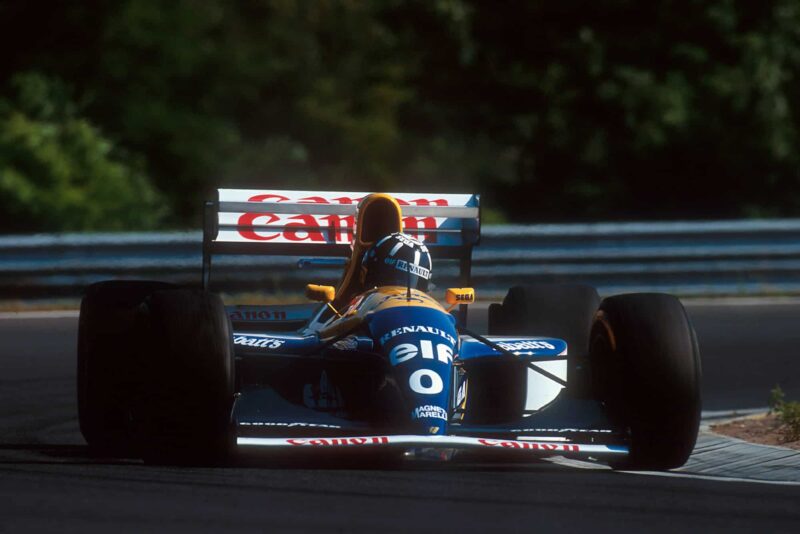
Hill on the way to his first F1 win
Motorsport Images
It was at this stage that Williams had a problem in the pits. After his initial disaster Prost had driven beautifully, rising through the field with metronomic precision. De Cesaris (who called at the pits on the first lap with a gear selection problem), Badoer and Alboreto succumbed immediately. On lap two the Williams went by Boutsen and Comas. A lap later it was Katayama, followed by an unhappy Mark Blundell on lap four. Lap five, Herbert. Lap six, Zanardi. Lap seven, Alliot. Lap eight, Fittipaldi. Lap nine, Lehto. Lap 11, Suzuki. Lap 12, Wendlinger. On successive laps from 15 to 19 inclusive, Brundle, Martini, Warwick, Alesi, Berger. It was a joy to watch. Then it all went wrong. He had closed on Patrese in third place by lap 20, but as Alain headed for the pits for what initially seemed like a straightforward tyre stop, he came in slower than one might have expected. The rear wing was loose, and close inspection revealed that the larger component used specifically for the Hungaroring had created so much extra downforce that it had over-stressed its support beam, which had subsequently delaminated. “Replacing that is a massive job,” said race engineer David Brown. “Normally it’s the last thing you’d think of doing in the pit lane.”
While they were working on the FW15C, the Williams pit entry was blocked of course, so that meant Hill couldn’t come in immediately without risking unnecessary delay. After a couple of laps the crew wheeled Alain further back so that Damon could come in and be despatched in 6.73s with fresh Goodyears, and after he’d lost seven laps Prost finally got going again. It says a lot for his motivation that, all chance of even one point gone, he went out to push, intent on fastest lap.
Schumacher came in a lap after Hill, on the 25th, sprinting away third after a very fast stop, but that was as far as he went. After powering back out in chase of Patrese, he ground to a halt on the service road behind the pits. The Benetton’s Ford HB had broken its auxiliary drive belt, possibly as a result of damage from all the debris the car had taken aboard during his off-course moments. Worse, he had shown himself to be fallible under pressure.
We now had a situation where Hill was way out in front, with all of his principal opponents sidelined and some 50 laps remaining! But if one form of pressure had gone, another took its place. “The tricky bit was getting past the backmarkers, because they made it very difficult. Some of them refused to go off line, which meant you had to move on to the dirty part of the track to get by. Your tyres then pick up all sorts of horrible rubber and dirt and are completely useless for a couple of laps after that. The pressure was coming from whether or not I could actually do it; finish off the job for the first time.”
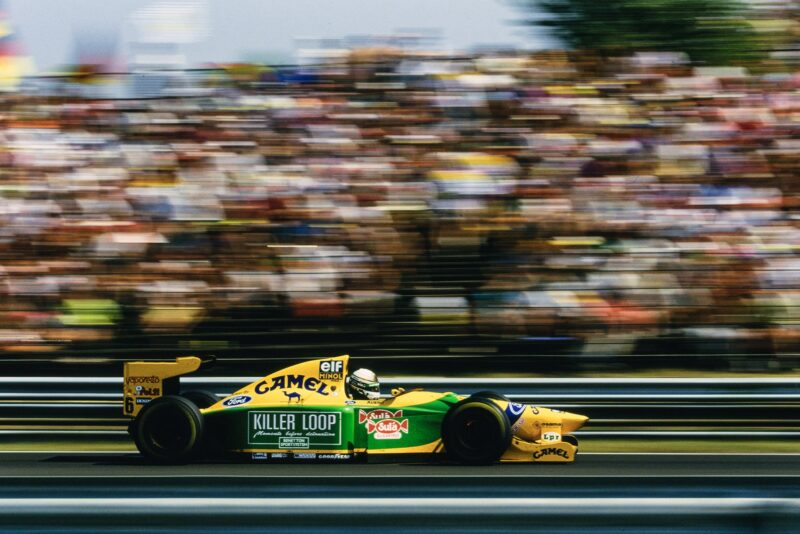
Riccardo Patrese in second for Benetton
Motorsport Images
Alesi joined the retirements on lap 23 as, recovering from his tyre stop, he tried passing Fittipaldi on the run to turn one. The Brazilian moved his Minardi to the left, they made contact, and as the M193 sustained terminal rear suspension -damage, the Ferrari aviated across the gravel bed on the outside of the curve and then hit the retaining wall head-on. Fortunately, Jean sustained only a slight knee injury and whiplash, but he was very upset about the incident.
By lap 30 Hill was thus 53.7s ahead of Patrese, who had stopped for tyres the previous lap. With Berger fighting back from his stop, third place had become a close battle between Warwick, Martini and Brundle, and this would prove one of the highlights. The little Italian had been the sensation of qualifying after setting sixth fastest time on Friday and then seventh on Saturday, but his fast start had slightly been negated by the Schumacher, Berger, Senna sort-out at the start. Thereafter he had settled in behind Warwick’s fast-driven Footwork, with Brundle thrusting along right behind. The three of them would run together throughout, Martini falling behind Martin after a slower tyre stop on lap 29. It was thus a great shame when Martini spun off on lap 60, as he had driven really well and everyone was happy to see Giancarlo Minardi’s team going so well and embarrassing so many with markedly larger budgets and technical advantage. This was, after all, a passive car with standard Ford HB V8, on a circuit whose bumps put active ride at a premium. Sadly, he lost control exiting the 10th turn and hit the barriers sideways on.
By that stage Berger was once again fighting back after a second tyre stop, on lap 52, and only Warwick stood between him and a podium finish. After Hockenheim the Briton was in no mood to surrender anything, as Brundle had already discovered, but his strategy called for only one tyre stop and by this point his Footwork was sliding all over the road. It was only a matter of time, and after Berger had already swiped Brundle aside in an unruly move in the left-hander behind the pits, Derek decided that commonsense was better than walking home. When Berger dived alongside on the inner line to turn one on lap 65, he finally conceded in gentlemanly fashion.
For many laps Warwick, Brundle and Martini had played a poker game over second tyre stops. Warwick, it transpired of course, wasn’t going to stop, but Brundle eventually pulled in on lap 61 and resumed in fifth place. In the closing laps he slashed the gap to Warwick, and as they went into the 70th their fight mirrored that between Wendlinger and Blundell for the final point. Martin got within a second of the Footwork, but then a gear selection problem made him run wide in the corner behind the pits, and after that the problem prevented him challenging any further. After a drive that reminded observers why Warwick deserves to be in F1, he took a good fourth. Like Brundle’s, Blundell’s charge lost impetus, leaving him seventh and angry that Aguri Suzuki’s slow start had lost him the advantage of what had been a hard-won 12th place on the grid. At one stage all five Britons were comfortably within the top 10, but a curious problem finally robbed Johnny Herbert of a likely sixth place or better for Team Castrol Lotus.
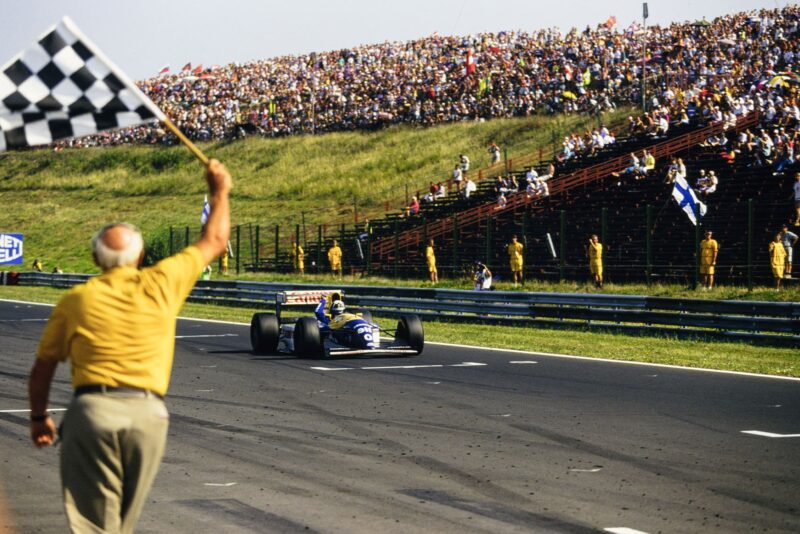
Hill takes the chequered flag to win in Hungary
Motorsport Images
The team had been in all sorts of trouble in qualifying, with broken engines and a sticking throttle on Herbert’s car which all but cancelled his second session, and had barely done any further development on its new traction control. By the race, however, things were better as he and team-mate Alessandro Zanardi moved through the field. The Italian had two time-consuming spins before breaking his transmission, but a cleverly planned tyre stop on lap 22 gave Herbert the wherewithal to move ahead of Wendlinger and Alliot. By lap 28 he had the Berger, Warwick, Brundle, Martini quartet in his sights and was biding his time to launch a serious challenge beyond mid-distance. Then, going into the first corner on lap 39, his 107B spun wildly and beached itself on the inner kerb, forcing him into retirement. The cockpit-mounted data storage box had worked loose, jamming his right hand between itself and the steering wheelMomentarily unable to apply sufficient lock, nor even to release his grip on the wheel, he was powerless to negotiate the corner.
For Hill, Hungary finally was the dream come true, and in the closing stages he came very close to lapping Patrese as the Italian, who felt unwell all weekend, lost the all-important third gear on his Benetton. Instead, however, Damon deliberately eased off his pace and as Berger went thirsting after the B193B, he wisely moved over and let him unlap himself. Riccardo held on to second place by six seconds, after the gallant Berger had slashed the deficit from 22 in seven laps. It had been a terrific performance from the Austrian, whose left elbow was very sore afterwards as he had undergone an operation on it only the previous week, and his numerous countrymen in the grandstands cheered him to the echo.
They cheered Hill, too, on an outstanding drive. It was nice to see the two old hands warmly congratulating the newcomer as they came together in parc ferme, where Hill freely admitted to feeling a little lost. On the podium he looked fresh and relaxed, and in the interviews afterwards the humour came through. Patrese, typically, was magnanimous to the man who, after all, had taken his seat at Williams. Flavio Briatore had left the track before the end, disinterested in his driver’s progress to second place. Riccardo’s comments said everything about his feelings towards Benetton. “I would like to congratulate Damon,” he said, “and also to congratulate his mechanics Les Jones, Robbie Campbell, Paul West and John Russell on their victory.”
“I can hardly find the words to explain howl feel at winning,” said Hill. “It is such an overwhelming feeling.” In only his 13th Grand Prix Damon Hill joined Britain’s past Grande Epreuve winners Mike Hawthorn, Tony Brooks, Peter Collins, Stirling Moss, lnnes Ireland, father Graham, Jim Clark, John Surtees, Jackie Stewart, Peter Gethin, James Hunt, John Watson and Nigel Mansell. It was a well driven and enormously popular triumph, and unlikely to be his last. D J T
